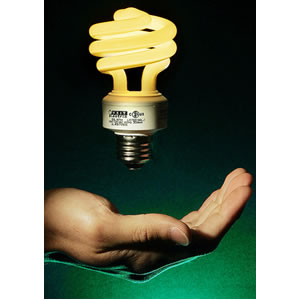- 19 reads

Did you know that using Compact Fluorescent Light bulbs (CFLs) in any light fixture that you use for more than two or three hours a day can save you hundreds of dollars on your household electric bill over the course of a decade?
While they are more expensive than traditional incandescent bulbs, CFLs last up to ten times longer and use only one-third the energy of their incandescent cousins. If every American home replaced just one light bulb with an Energy Star rated CFL, we would save enough energy to light more than 2.5 million homes for a year, while preventing green house gases equivalent to the emissions of nearly 800,00 cars.
To be more specific, each CFL will save $30 or more in energy costs over the course of its lifetime. They also generate 70% less heat than incandescent, so they are safer to operate and can cut energy costs associated with home cooling.
In addition to other quality requirements, Energy Star rated CFLs must turn on instantly, produce no sound, and fall within a warm color range or otherwise be labeled as providing cooler color tones. They are available in different sizes and shapes, so they will fit in almost any fixture, either for indoor or outdoor use.
Just as there is no such thing as a free lunch, CFLs are not perfectly eco-friendly. The average CFL contains about 5 milligrams of Mercury that can leach into the soil once it arrives at the landfill. To put that in perspective, older home thermometers contain roughly 500 milligrams of Mercury while older home thermostats contain as much as 3,000 milligrams.
Even as its Mercury content is relatively low, some manufacturers such as Philips make very low-Mercury content CFLs, while the "Mercury-free" CFL is being produced as we speak. Regardless, these bulbs should be disposed of properly. Safe disposal requires storing the bulbs unbroken until they can be processed. Usually, one can either bring the bulbs back to the store from which they were purchased so that they can handle the recycling from there.
But, as with the disposal of many newer products, it is important that you seek advice from local authorities when discarding something that could potentially have high levels of toxins or chemicals. Earth911.org is a great source of information on how to dispose of CFLs in your area.
For those consumers who are really shooting for an invisible carbon footprint, the Mercury content of CFLs might be a deal breaker. However, there are still better options than candles. Light Emitting Diodes last 10 times as long as CFLs, and contain no Mercury. They are safer, use less energy, and last longer. The only problem is that they cost more. As science progresses and the Green Market solidifies itself as a consumer-force, these bulbs will come down in price and become much more commonplace. But until then, try to stay away from the incandescent!
GREENandSAVE.com is a free resource for anyone that wants to save energy, money, and the environment. The articles, product reviews, online tools, and return on investment calculations are researched from a diverse range of public and private sector sources. Overall, the company is passionate about saving money as well as creating healthy homes, offices, and lifestyles.
To hear the audio for this and other Great Green Home Show radio segments, visit the "On the Radio" section on GREENandSAVE.com.To learn more about improving your energy habits, take a look at the Green Lifestyle section of GREENandSAVE.com Or, for more energy saving tips, take a look at the GREENandSAVE Return on Investment Table, which will help to prioritize your next Green Home Remodeling project.

